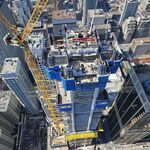TheTigerMaster
Superstar
Anything is that TC {and very much Eglinton} was based on Miller's population estimate of Toronto reaching 4 million by 2030 but it set to cross that marker with 1 to 2 years and will probably be closer to 3.5 million by 2030.
Who is expecting Toronto to have a population of 4 Million by 2030? That prediction seems outlandish.
This line will only be able to have frequencies of every 4 minutes each way max as opposed to a grade separated line that could run every 90 seconds and be cheaper to run due to automation.
Source for this?






